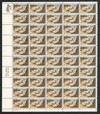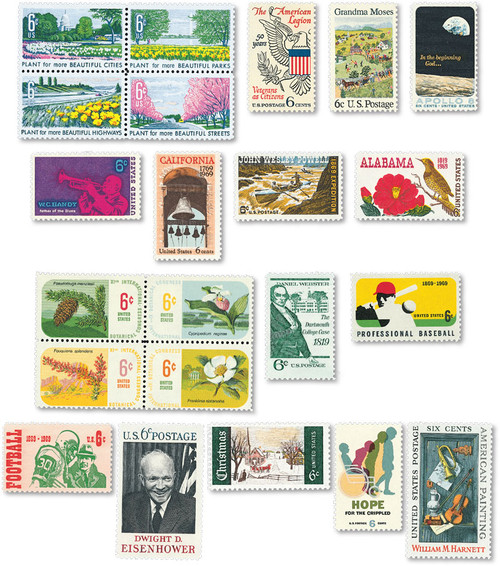
# 1374 - 1969 6c John Wesley Powell
Issue Date: August 1, 1969
City: Page, AZ
Quantity: 135,875,000
Printed By: Bureau of Engraving and Printing
Printing Method: Lithographed, engraved
Perforations: 11
Color: Black, ocher and light blue
This stamp honors John Wesley Powell, who was the first white man to explore the Green and Colorado Rivers when he made the perilous journey along a 1,000-mile stretch of the Grand Canyon.
Birth Of John Wesley Powell
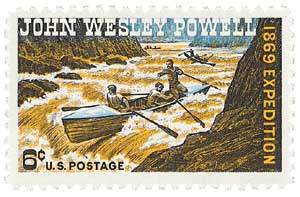
Soldier, geologist, and explorer John Wesley Powell was born on March 24, 1834, in Mount Morris, New York.
When he was a child, Powell’s family moved to Ohio before settling in Illinois. In his teens and early 20s Powell explored the Mississippi River Valley and walked across Wisconsin for four months. Powell attended college for several years, while also teaching, but didn’t earn his degree. By 1860, he realized that America was destined for war and began studying military science and engineering.
Powell supported the Union and opposed slavery, so he joined the Union Army in the 20th Illinois Infantry. He was elected sergeant major of his regiment and was promoted to second lieutenant. During the war, he served as a mapmaker and military engineer.
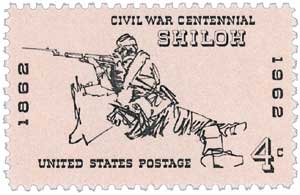
While stationed in Missouri, Powell formed an artillery company and became captain. In the Battle of Shiloh, he was hit by enemy fire and lost his right arm. In spite of his injury, Powell returned to the army and participated in the siege of Vicksburg and the Atlanta Campaign. He always had an interest in geology and was known to study rocks in the trenches.
After the war, Powell became a professor of geology at a university in Illinois. He helped the institution expand their natural history museum. They offered him a permanent position, but he was anxious to explore the American West.
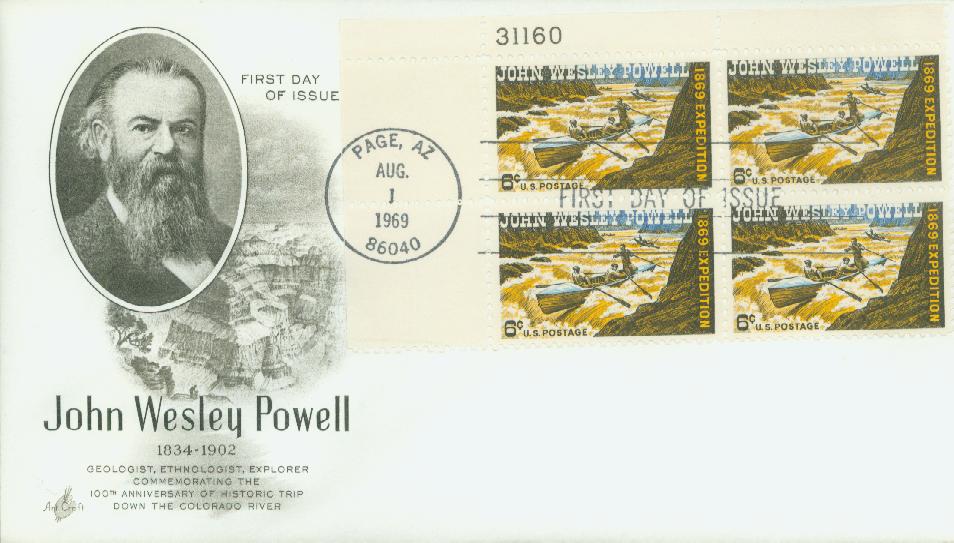
By 1868, Powell had studied countless reports and spoke with Indians, hunters, and mountain men, that all convinced him that exploring the Colorado River on small boats would be possible. He petitioned the War Department and the Smithsonian Institution for assistance and they provided him with scientific instruments to collect samples and further study the area. In time, Powell acquired four boats and gathered enough supplies and food to last him and his crew of nine for six to nine months.
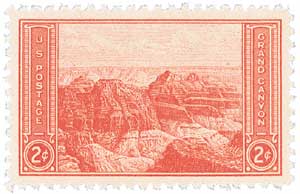
On May 24, 1869, Powell and his men began their journey in Wyoming’s Green River, while locals stood on the shore shouting and cheering, encouraging them though they expected to never see the men again. While making their way downstream, Powell accurately suggested that the river had existed long before the canyons and that it had cut through the rock as the plateau rose.
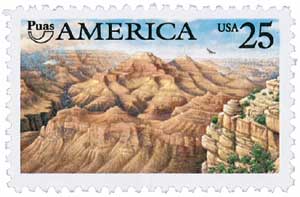
Along their journey, Powell and his party named many sites in the Grand Canyon, including Flaming Gorge, Canyon of Lodore, Whirlpool Canyon, Split Mountain, Dirty Devil stream, Bright Angel stream, Gray Canyon, and Marble Canyon. Three months into the expedition, the party reached their destination – the Virgin River. They had traveled 1,000 miles through uncharted canyons and Powell returned home a national hero.
Upon his return home to Illinois, Powell immediately began lecturing to raise money for a second trip. His first trip had been so successful, he had little trouble getting money from Congress. His 1871-72 expedition through the Grand Canyon was even more successful – producing the first accurate maps of the area, and over 100 photographs.
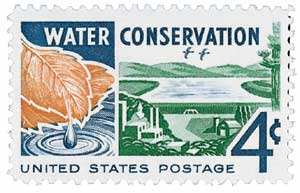
Powell went on to become director of the U.S. Geological Survey as well as the Bureau of Ethnology at the Smithsonian. He also published a book about his expeditions. Based on his trips, Powell submitted a report on the West, suggesting state boundaries and irrigation systems based on watershed areas, to prevent disagreements among the states. He also had suggestions for conservation that railroad companies didn’t agree with. In the end Congress supported the agricultural use of the land based on the belief that “rain follows the plow.” However, Powell was correct and his fears would later prove true in the Dust Bowl of the 1920s and 30s.
Powell died on September 23, 1902, at his summer home in Haven, Maine. As a Civil war veteran, he was buried in Arlington Cemetery.
Click here for photos from Powell’s expeditions.
Issue Date: August 1, 1969
City: Page, AZ
Quantity: 135,875,000
Printed By: Bureau of Engraving and Printing
Printing Method: Lithographed, engraved
Perforations: 11
Color: Black, ocher and light blue
This stamp honors John Wesley Powell, who was the first white man to explore the Green and Colorado Rivers when he made the perilous journey along a 1,000-mile stretch of the Grand Canyon.
Birth Of John Wesley Powell

Soldier, geologist, and explorer John Wesley Powell was born on March 24, 1834, in Mount Morris, New York.
When he was a child, Powell’s family moved to Ohio before settling in Illinois. In his teens and early 20s Powell explored the Mississippi River Valley and walked across Wisconsin for four months. Powell attended college for several years, while also teaching, but didn’t earn his degree. By 1860, he realized that America was destined for war and began studying military science and engineering.
Powell supported the Union and opposed slavery, so he joined the Union Army in the 20th Illinois Infantry. He was elected sergeant major of his regiment and was promoted to second lieutenant. During the war, he served as a mapmaker and military engineer.

While stationed in Missouri, Powell formed an artillery company and became captain. In the Battle of Shiloh, he was hit by enemy fire and lost his right arm. In spite of his injury, Powell returned to the army and participated in the siege of Vicksburg and the Atlanta Campaign. He always had an interest in geology and was known to study rocks in the trenches.
After the war, Powell became a professor of geology at a university in Illinois. He helped the institution expand their natural history museum. They offered him a permanent position, but he was anxious to explore the American West.

By 1868, Powell had studied countless reports and spoke with Indians, hunters, and mountain men, that all convinced him that exploring the Colorado River on small boats would be possible. He petitioned the War Department and the Smithsonian Institution for assistance and they provided him with scientific instruments to collect samples and further study the area. In time, Powell acquired four boats and gathered enough supplies and food to last him and his crew of nine for six to nine months.

On May 24, 1869, Powell and his men began their journey in Wyoming’s Green River, while locals stood on the shore shouting and cheering, encouraging them though they expected to never see the men again. While making their way downstream, Powell accurately suggested that the river had existed long before the canyons and that it had cut through the rock as the plateau rose.

Along their journey, Powell and his party named many sites in the Grand Canyon, including Flaming Gorge, Canyon of Lodore, Whirlpool Canyon, Split Mountain, Dirty Devil stream, Bright Angel stream, Gray Canyon, and Marble Canyon. Three months into the expedition, the party reached their destination – the Virgin River. They had traveled 1,000 miles through uncharted canyons and Powell returned home a national hero.
Upon his return home to Illinois, Powell immediately began lecturing to raise money for a second trip. His first trip had been so successful, he had little trouble getting money from Congress. His 1871-72 expedition through the Grand Canyon was even more successful – producing the first accurate maps of the area, and over 100 photographs.

Powell went on to become director of the U.S. Geological Survey as well as the Bureau of Ethnology at the Smithsonian. He also published a book about his expeditions. Based on his trips, Powell submitted a report on the West, suggesting state boundaries and irrigation systems based on watershed areas, to prevent disagreements among the states. He also had suggestions for conservation that railroad companies didn’t agree with. In the end Congress supported the agricultural use of the land based on the belief that “rain follows the plow.” However, Powell was correct and his fears would later prove true in the Dust Bowl of the 1920s and 30s.
Powell died on September 23, 1902, at his summer home in Haven, Maine. As a Civil war veteran, he was buried in Arlington Cemetery.
Click here for photos from Powell’s expeditions.







